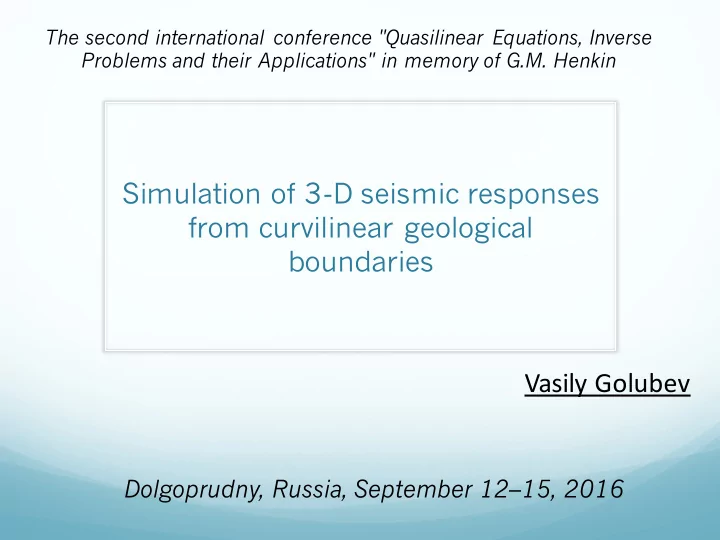

The second international conference "Quasilinear Equations, Inverse Problems and their Applications" in memory of G.M. Henkin Simulation of 3-D seismic responses from curvilinear geological boundaries Vasily Golubev Dolgoprudny, Russia, September 12–15, 2016
Outline Problem Formulation Mathematical Model and Numerical Method Explicit Layers Description Results of Simulation Conclusion
Marine seismic survey http://www.keyword-suggestions.com
Land seismic survey http://www.energyindustryphotos.com/
Relevance of research Optimization of sources and receivers positions to increase signal/noise ratio Estimation of seismic survey applicability in the case of known properties of geological massive Preparation of synthetic material for testing novel inversion/migration methods
Mathematical model and numerical method ⃗ = (𝛼 ) 𝜏) , 𝜍𝜖 # 𝑤 ⃗ , 𝐽 + 𝜈(𝛼 ⊗ 𝑤 ⃗ , ) 𝜖 # 𝜏 = 𝜇 𝛼 ) 𝑤 ⃗ + 𝛼 ⊗ 𝑤 𝜍 – density, 𝑤 ⃗ – velocity, 𝜏 – Cauchy ¡stress ¡tensor, 𝜇 , 𝜈 – Lame ¡parameters. 3D ¡elastic ¡system ¡of ¡equations, ¡grid-‑characteristics ¡ numerical ¡method ¡on ¡hexahedral ¡meshes ¡was ¡used
Explicit layers description Implicit contact borders (medium parameters – functions of coordinates) – “rough borders” Explicit contact borders – one mesh per layer Curvilinear mesh to describe complex geometry of layers – “smooth borders” Correct solution on each time step – glue conditions
RECT Software Numerical simulation of waves propagation in 3D elastic (geological medium) and 3D acoustic (water) models Implicit/Explicit heterogeneities (multilayer, cracks, inclusions) C++, micro optimization (SIMD, SSE) OpenMP and MPI parallelization Main developer: Khokhlov N.I.
HPC systems usage Ø Clusters: ¡MIPT-‑60, ¡HECToR Ø Scalability ¡~16 ¡000 ¡cores Ø Efficiency ¡~ 80 ¡%
Numerical results – model description No V p , m/s V s , m/s ρ , kg/m 3 1 2170 674 2000 2 2130 795 2300 3 2500 1090 2200 4 2680 1220 2300 5 3000 1385 2400 6 5550 3144 2700 7 6000 1250 2800 8 6000 1550 2850 North-east of the European part of the Russian Federation on the territory of the Arkhangelsk Region within the Nenets Autonomous District, north of the Arctic Circle almost to the shores of the Barents Sea
Numerical results - seismograms A A 1 2 A1, implicit A1, explicit A2, implicit A2, explicit Time, s 815 7415 210 1908 Memory, Gb 21,7 47,5 31,3 68,5 ∆ 1 22 % 39 % ∆ 2 26 % 36 % ∆ 3 30 % 34 %
Numerical results – wavefield A1, implicit A1, explicit A2, implicit A2, explicit Time, s 815 7415 210 1908 Memory, Gb 21,7 47,5 31,3 68,5 ∆ 1 22 % 39 % ∆ 2 26 % 36 % ∆ 3 30 % 34 %
Conclusion Explicit layers description changes amplitudes, but remain arrival times RECT, in the case of modern HPC systems usage, can be used to simulate seismic survey with high precision in complex media
Thank ¡you ¡for ¡your ¡ attention!
Key feature of RECT Explicit description of any inclusions (cracks) Crack-crack interaction
Recommend
More recommend